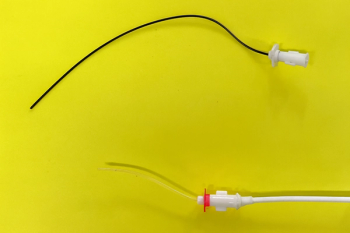
Management of male cats with urethral obstruction (Proceedings)
Urethral plugs are the most common cause of obstruction in male cats.
Pathophysiology of urethral obstruction
Urethral plugs are the most common cause of obstruction in male cats. In one series (Krueger 1991), urethral plugs occurred in 60%, no cause was found in 30%, uroliths alone were documented in 10% (struvite exclusively) and uroliths with bacterial urinary tract infection were observed in 2%. Occasionally stricture and rarely neoplasia are the causes of obstruction. Urethral obstruction due to calcium oxalate urethroliths is a phenomenon of the 1990's that was not encountered in the 1980's.
Figure 1. Underlying causes and mechanisms of urethral obstruction
Urethral plugs consist of proteins and embedded constituents of the urine in varying proportion. They contain little internal structure, and most commonly form in the penile urethra. Lower urinary tract inflammation, caused by either idiopathic cystitis/urethritis or bladder stones, precedes the formation of urethral plugs. Struvite still comprises the major crystal in plugs, despite the emergence of calcium oxalate crystalluria. Inflammatory exudates of white blood cells and proteins, red blood cells from hemorrhage, sloughed epithelial cells, fibrin, calcium oxalate crystals, and calici-like viral particles may also become trapped if present in urine at the time of plug formation.
In addition to intraluminal obstruction, lesions of the urethral wall may also contribute to obstruction. Edema, hemorrhage, and inflammation contribute to urethritis and can decrease the diameter of the urethral lumen. Functional decreases of the urethral lumen diameter also may result from inflammation and pain (see spasm below). Cats with chronic urethritis or recurrent urethral obstruction may become obstructed secondary to urethral stricture. Extramural causes (prostatic or urethral tumor) of urethral obstruction are exceedingly rare.
Figure 2
Most plugs cause obstruction within the penile urethra, but obstructions can also occur at more proximal sites. The predominant mineral composition in most plugs is magnesium ammonium phosphate (struvite). Secondary components can contribute to plug formation including inflammatory exudate ( WBC and proteins), red blood cells, cellular debris, sloughed tissue (epithelial cells), struvite crystals and combinations. Virus-like particles resembling calicivirus and bacteria have also been observed within urethral plugs examined by transmission electron microscopy. Primary inflammatory changes ( exudates, blood, and edema) or changes within the urethral wall secondary to intraluminal urethral plugs may contribute to the obstructive process. These changes may be magnified following instrumentation with catheters and back-flushing solutions used in therapeutic endeavors.
Diagnostics and management
Urethral obstruction is diagnosed by the finding of an enlarged bladder in a male cat with signs of urinary urgency, difficulty in manually expressing urine, and by resistance encountered during the passage of a urethral catheter. It may not be obvious what is causing the urethral obstruction. Diagnostics and management of urethral obstruction are performed simultaneously. The degree of uremia, electrocardiographic stability, and the magnitude of bladder distention will dictate how quickly and in what order treatment must be performed. Those cats with uremic crisis and those with very large hard bladders are in need of prompt attention.
Figure 3. Approach to the Moribund Cat with Advanced Urethral Obstruction
Relief of obstruction due to plugs
Cystocentesis to drain the bladder(decompressive or therapeutic cystocentesis) should be performed as soon as possible in cats with very large bladders to prevent rupture of the bladder and to allow excretory renal function to resume. Relief of bladder pressure prior to urethral catheterization also may facilitate efforts to dislodge urethral plugs, and provides a superior urine sample for analysis prior to manipulation of the urinary tract and contamination with flushing solutions. Plain abdominal/perineal radiographs should follow the decompressive cystocentesis so mineralized plugs can be documented or that cystic and/or urethral calculi can be identified ( a lateral radiograph often suffices).
Chemical restraint/anesthesia (isoflurane, low-dose IV ketamine, propofol) is often advisable to atraumatically relieve the obstruction via urethral catheterization. Urethral relaxation while under sedation/anesthesia may further increase the likelihood of plug dislodgment. Little or no sedation is indicated for those with severe uremia. Gentle massage of the penis may dislodge a urethral plug located in the penile urethra, especially when near the external urethral orifice. Gentle pulsatile bladder palpation following penile massage may cause a plug to be expelled. Rectal massage of the pelvic urethra may on occasion also contribute to plug dislodgment. Aseptic and gentle technique should be used while placing a urethral catheter. Urethral irrigation with sterile physiologic solutions (Lactated Ringer's solution or 0.9% saline ) may now dilate the urethra and flush the obstructing plug distally out the external urethral opening around the catheter. Intermittent gentle digital pressure on the bladder following irrigation attempts may change the pressure on the urethral plug and force it to be expelled through the external urethral orifice. Care must be taken to ensure that excessive trauma or rupture of the bladder does not occur during this maneuver. Hydropulsion (reverse flushing) within the urethra may be attempted at this point if the obstruction is not yet relieved. The urethra is thoroughly flushed to make sure that all debris initially within the lumen has been back-flushed into the bladder or has been refluxed out the urethra. The urethral catheter can then usually be advanced into the bladder. Failure to adequately remove debris from the bladder and urethra is a major cause of rapid re-obstruction following catheter removal.
"Urethral spasm" refers to pathologic neurogenic or myogenic processes that contract the circular smooth and/or skeletal muscle of the urethra. The bladder and preprostatic segments of the urethra contain primarily smooth muscle, the prostatic and postprostatic segments contain both smooth and skeletal muscle, and the musculature of penile segment is predominantly circular skeletal muscle. Innervation of the urethra is provided by the sympathetic nervous system via the hypogastric nerve and the somatic nervous system via the pudendal nerve. Part of urethral tone maintained by the skeletal muscle (rhabdosphincter) is influenced by sympathetic innervation.
Stimulation of adrenoreceptors (particularly a-1) within the urethra increases urethral tone in normal cats. It is likely that both pain and stress associated with urethral obstruction increases sympathetic outflow from the central nervous system, favoring urethral spasm. Urethritis may exist prior to plug formation, or may be acquired secondary to trauma from the physical presence of intraluminal plugs or stones. Attempts to relieve obstruction with catheters, and indwelling urethral catheters also can result in urethritis. Urethritis may also be secondary to bacterial urinary tract infection (UTI) that is commonly acquired following placement of indwelling urinary catheters, even when a closed urinary collection system is employed. The use of antibacterial treatment does not prevent UTI.
To reduce pain and inflammation associated with intraluminal obstructing material, all material must be removed from the urethra. Using gentle technique during urethral catheterization and flushing is essential to minimize iatrogenic damage to the urethra (erosion, inflammation, perforation). Installation of an indwelling urethral catheter can be an additional source of pain and urethritis, which should be avoided if possible. Repeated cystocentesis to empty the bladder is an alternative to passage of another urethral catheter if obstruction recurs following removal of the initial catheter. Repeated cystocentesis also provides indirect pain relief by keeping the bladder small and painful mucosal surfaces non-distended.
Drugs recommended for the treatment of urethrospasm include analgesic, anti-inflammatory, antibacterial, and spasmolytic agents. Injection of diluted lidocaine solution through the urethral catheter at the time of its removal has been advocated by some to reduce urethral spasms, but this has not been critically evaluated. Also, the local effects of lidocaine on urothelial healing are unknown. If used, lidocaine should be diluted and injected slowly at low pressure – excessive amounts of systemically absorbed (> 0.5 mg/kg IV) lidocaine can cause seizures. Systemic treatment with a fentanyl (patch), low dose morphine (0.05-0.2 mg/kg IM), butorphanol (0.05-0.2 mg/kg IM), and/or low dose medetomidine (2-5 micrograms/kg IM ; centrally acting alpha-2 agonist that decreases sympathetic outflow) for relief of pain seems reasonable. It is possible that relief of pain will decrease urethral and bladder muscle spasms. Opioids increase urethral sphincter tone, increase bladder volume, and inhibit voiding initially but tolerance to these effects develops quickly. The central analgesic effects of opioids are most important. Butorphanol is a weak opioid that can be considered for use during the initial 12-24 hours. Unfortunately, patients develop tolerance to butorphanol rapidly. Butorphanol also has a ceiling effect in which increased doses provide no further analgesia. Finally, butorphanol produces agonist effects at kappa receptors and antagonist effects at mu receptors. This may decrease the effects of more potent mu opioids (morphine, oxymorphone, fentanyl) when needed. When additional analgesia is needed, combinations of drugs that act by different mechanisms should be considered. For example, morphine (opioid) and medetomidine (alpha 2 agonist) may be given every 6 to 12 hours as needed. Ketoprofen, tolfenamic acid, and carprofen are non-steroidal anti-inflammatory drugs (NSAID) that have been used in cats, but their effectiveness in decreasing lower urinary tract inflammation has not been substantiated. Adding an NSAID to this regimen might provide the most complete level of analgesia.
Newsletter
From exam room tips to practice management insights, get trusted veterinary news delivered straight to your inbox—subscribe to dvm360.





